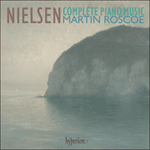Nielsen himself confessed that his
Chaconne Op 32 was modelled on the famous Bach work for solo violin. In a letter to his daughter, Irmelin Eggert-Møller, Nielsen revealed: ‘You know Bach’s delightful Ciaconne for solo violin, of course. If only I could reach his shoulders with mine for piano!’ The work begins with the eight-bar ground bass theme played alone in the left hand; this provides the basis for the whole piece. The right-hand melody which then emerges in counterpoint with the bass gradually develops, as the work evolves, into an independent countersubject. At times the figuration recalls the kind of writing associated with Bach’s solo violin music. For the most part, however, the variations are entirely pianistic in conception. Increasingly florid and delicate, the
Chaconne briefly reaches a moment of hymn-like calm and repose before unleashing a shatteringly violent and dramatic central climax, with harsh dissonant chords hammered in both hands above a simplified version of the bass theme in the piano’s lowest register. As this climax eventually subsides, the countersubject returns, before a crystalline coda closes the work in the major key, the final page ascending ever higher into the upper register of the keyboard. Not so much a sense of transcendence, perhaps, as a gesture of perfect balance and stability.
from notes by Daniel Grimley © 2008
Nielsen reconnut avoir modelé sa
Chaconne, op. 32, sur la fameuse pièce pour violon solo de Bach. Dans une lettre adressée à sa fille, Irmelin Eggert-Møller, il déclara: «Tu connais bien sûr la charmante Ciaconne pour violon solo de Bach. Si seulement je pouvais lui arriver à l’épaule avec la mienne pour piano!» L’œuvre s’ouvre sur un thème de basse obstinée (huit mesures) qui, joué seul à la main gauche, sert de base à toute la pièce. La mélodie de la main droite, qui émerge ensuite en contrepoint avec la basse, se mue peu à peu en un contre-sujet indépendant. Parfois, la figuration évoque le type d’écriture associée à la musique pour violon solo de Bach, mais l’essentiel des variations demeure de conception entièrement pianistique. Toujours plus fleurie et délicate, cette
Chaconne atteint un moment de calme hymnique et de repos avant de libérer un apogée central dramatique, extraordinairement violent, avec de durs accords dissonants martelés aux deux mains par-dessus une version simplifiée du thème de basse, dans le registre le plus grave du piano. Cet apogée finit par s’estomper et le contre-sujet revient avant qu’une coda cristalline ne close l’œuvre en majeur, la page finale allant toujours plus haut dans les aigus du clavier. Mais peut-être n’est-ce pas tant de la transcendance qu’un geste de parfait équilibre et de stabilité.
extrait des notes rédigées par Daniel Grimley © 2008
Français: Hypérion
Nielsen selbst gab zu, dass sich seine
Chaconne op. 32 an Bachs berühmtem Werk für Violine solo ein Vorbild genommen hatte. In einem Brief an seine Tochter, Irmelin Eggert-Møller, offenbarte Nielsen: „Du kennst sicher Bachs herrliche Ciaconne für Violine solo. Wenn ich ihr doch nur mit meiner für Klavier annähernd das Wasser reichen könnte!“ Das Werk beginnt mit einem achttaktigen Bassthema, das nur mit der linken Hand vorgetragen wird und die Grundlage für das gesamte Stück bildet. Die sich im Kontrapunkt zum Bassthema herausschälende Melodie in der rechten Hand entwickelt sich im weiteren Verlauf des Stückes allmählich zu einem eigenständigen Gegenthema. Zuweilen erinnern die Umspielungen an die Art von Musik aus Bachs Soloviolinwerken. Meistens sind die Variationen aber völlig pianistisch empfunden. Die
Chaconne wird zunehmend blumiger und delikat und erreicht kurz einen Moment hymnischer Ruhe und Gelassenheit, worauf in der Werkmitte ein erschütternd brutaler und dramatischer Höhepunkt erreicht wird, auf dem beide Hände harsche dissonante Akkorde über einer vereinfachten Version des Bassthemas im tiefsten Register des Klaviers hämmern. Wenn diese Spannung endlich nachlässt, kehrt das Gegenthema wieder zurück, bevor eine kristalline Koda das Werk in der Durtonart beschließt. Die letzte Seite steigt immer weiter in die hohen Register des Klaviers auf. Wohl weniger eine Art Transzendenz als eine Geste perfekter Balance und Stabilität.
aus dem Begleittext von Daniel Grimley © 2008
Deutsch: Elke Hockings


 Nielsen: Complete Piano Music
Nielsen: Complete Piano Music
